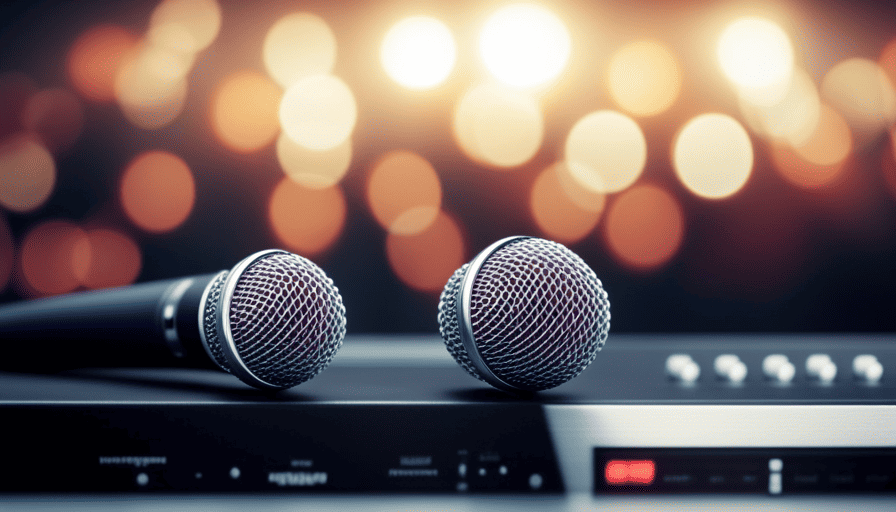So, you have made a smart choice to enhance your karaoke experience by adding a wireless microphone to your setup. Good decision! No more tripping over cables or being stuck in one spot while singing your heart out to your favorite tunes.
But how do you actually connect that wireless microphone to your karaoke system? Fear not, because we’re here to guide you through the process step by step.
First things first, you’ll need to determine if your karaoke system is compatible with a wireless microphone. Once you’ve confirmed compatibility, it’s time to choose the right wireless microphone for your needs.
Then, set up the wireless microphone receiver and connect it to your karaoke system. Power on the wireless microphone system and give it a test run. Don’t forget to adjust the microphone settings for optimal performance.
With practice, using a wireless microphone will become second nature to you. And if any connectivity issues arise along the way, we’ve got troubleshooting tips at the ready.
So get ready to unleash your inner superstar and enjoy the freedom of singing wirelessly with confidence!
Key Takeaways
- Determine compatibility of karaoke system with wireless microphone
- Set up wireless microphone receiver by checking compatibility and connecting antennas
- Troubleshoot connectivity issues by checking cables and avoiding interference sources
- Optimize microphone sound quality by adjusting volume controls and gain knobs
Determine the Compatibility of Your Karaoke System
Now, let’s figure out if your karaoke system is compatible with a wireless microphone. Determining compatibility is crucial to ensure that you can enjoy the benefits of a wireless setup without any connectivity issues.
To begin, check the specifications of your karaoke system and look for any indications of wireless microphone compatibility. Look for features such as built-in wireless receiver or input options specifically designed for wireless microphones.
If you can’t find explicit information about compatibility in the system’s manual or specifications, don’t worry. Next, examine the available inputs on your karaoke system. Most modern systems have standard audio input options like XLR or 1/4-inch jacks. Wireless microphones typically come with a receiver unit that connects to these inputs using appropriate cables.
In case your karaoke system lacks compatible inputs, it may be necessary to purchase additional equipment such as an adapter or mixer that can bridge the gap between your system and the wireless microphone.
By troubleshooting connectivity and ensuring compatibility between your karaoke system and wireless microphone, you’ll be one step closer to delivering an amazing singing experience. Now, let’s move on to choosing the right wireless microphone for your setup without any delay!
Choose the Right Wireless Microphone
First, you’ll want to make sure you’ve got the perfect microphone in your hand for belting out those karaoke tunes. When choosing a wireless microphone for your karaoke system, there are a few important factors to consider. The wireless microphone range is crucial as it determines how far away from the receiver you can be while still maintaining a clear signal. Look for a microphone with a range that suits your needs and the size of your karaoke setup.
Another important consideration is wireless microphone frequency interference. This refers to the potential for other electronic devices or nearby wireless systems to interfere with the signal of your microphone. To avoid this problem, select a wireless microphone that operates on different frequencies than any other devices in your vicinity.
To assist you in finding the right wireless microphone, refer to the table below:
| Microphone Model | Range (in feet) | Frequency Range (in MHz) |
|---|---|---|
| Model A | 100 | 500 – 600 |
| Model B | 150 | 600 – 700 |
| Model C | 200 | 700 – 800 |
Once you have chosen the ideal wireless microphone for your karaoke system, it’s time to set up the wireless microphone receiver and ensure everything is properly connected.
Transitioning into the next section about setting up the wireless microphone receiver…
Set Up the Wireless Microphone Receiver
Once you’ve selected the perfect wireless microphone, it’s time to get your receiver up and running smoothly. Here are some tips for setting up the wireless microphone receiver:
-
Check compatibility: Ensure that the receiver is compatible with your karaoke system. Consult the user manual or contact the manufacturer if you’re unsure.
-
Connect antennas: Attach the included antennas securely to the receiver. Position them vertically for optimal signal reception.
-
Power on and sync: Plug in the power adapter and turn on the receiver. Follow the manufacturer’s instructions to sync it with your microphone. This usually involves pressing a button or entering a code.
-
Adjust settings: Use the controls on the receiver to adjust volume levels, frequency channels, and any other necessary settings. Refer to the user manual for specific instructions.
These troubleshooting steps can help resolve common connectivity issues:
-
Check cables: Make sure all cables connecting the receiver to your karaoke system are securely plugged in.
-
Interference sources: Keep electronic devices like routers or smartphones away from both your microphone and receiver, as they can cause interference.
Now that you’ve successfully set up your wireless microphone receiver, it’s time to connect it to your karaoke system seamlessly without any interruptions.
Connect the Receiver to Your Karaoke System
To achieve the pinnacle of auditory bliss, behold the harmonious union between your melodious transmitter and the majestic realm of sonic amplification. Now that you have set up your wireless microphone receiver, it’s time to connect it to your karaoke system. This step is crucial in ensuring seamless audio transmission and compatibility between devices.
Before connecting the receiver, consider checking for compatibility issues with your karaoke system. Refer to the user manual or contact the manufacturer for any specific requirements or recommendations. Once you have confirmed compatibility, follow these steps:
- Locate the audio output ports on your receiver and identify the corresponding input ports on your karaoke system.
- Connect one end of an audio cable (usually RCA or XLR) to the output port on the receiver.
- Connect the other end of the cable to the input port on your karaoke system.
- Ensure a secure connection by tightening any necessary screws or latches.
- Repeat this process for each channel if you are using multiple microphones.
By successfully connecting your wireless microphone receiver to your karaoke system, you establish a vital link in delivering impeccable sound quality during vocal performances. Now that everything is connected, let’s move on to powering on the wireless microphone system for an unforgettable experience.
[SUBSEQUENT SECTION: ‘Power On The Wireless Microphone System’]Power On the Wireless Microphone System
Now, it’s time to unleash the captivating symphony by igniting the power within your wireless microphone system. Before you power on the system, make sure all connections are securely in place. Double-check that the receiver is properly connected to your karaoke system using the appropriate cables. Once you’ve confirmed this, locate the power switch on both the receiver and the wireless microphone itself.
First, turn on the receiver by flipping its power switch to the ‘On’ position. Wait for a few moments as it initializes and establishes a connection with the wireless microphone. Keep an eye out for any indicator lights that will signify successful power-up and connection.
Next, power on your wireless microphone by pressing and holding its power button until you see or hear an indication that it’s turned on. It may be accompanied by a light or beep sound. If there are any issues with powering up either device, refer to your user manual or troubleshoot microphone interference if necessary.
Once both devices are powered on and connected, take a moment to optimize microphone sound quality. Adjust any available settings, such as volume controls or gain knobs, to achieve optimal audio levels without distortion or feedback.
After successfully powering on your wireless microphone system and optimizing its sound quality, it’s time to move on to pairing the microphone with the receiver for seamless performance throughout your karaoke session.
Pair the Microphone with the Receiver
To successfully connect your wireless microphone to the karaoke system, you must first power on the wireless microphone system, as explained in the previous subtopic. Once the system is powered on, it is time to pair the microphone with the receiver.
Pairing ensures that the receiver recognizes and communicates with your specific microphone. To do this, follow these steps:
- Turn on both the microphone and receiver.
- Press and hold the pairing button on the receiver until its indicator light starts flashing.
- Press and hold the pairing button on the microphone until its indicator light starts flashing.
- Wait for a few seconds until both lights become solid, indicating successful pairing.
In some cases, you may encounter issues during this process or experience problems with microphone compatibility due to different frequency ranges. Troubleshooting such issues can be done by referring to your specific microphone and receiver manuals or seeking professional assistance.
Understanding microphone frequency compatibility is crucial for avoiding interference or signal loss between devices. It’s important to ensure that both your wireless microphone and receiver operate within compatible frequency ranges.
Once you have successfully paired your wireless microphone with the receiver, it’s time to test it out!
Test the Wireless Microphone
Once you’ve successfully paired your wireless microphone with the receiver, it’s time to give it a test run and feel the power of your voice! Testing the wireless microphone is crucial to ensure that its quality meets your expectations.
Begin by positioning yourself at a comfortable distance from the karaoke system and turn on both the receiver and the microphone. Speak or sing into the microphone while monitoring the audio output through speakers or headphones connected to the system. Pay close attention to any distortion, background noise, or weak signals that may affect sound quality.
To troubleshoot audio interference, try changing positions within the room and observe if it affects the clarity of your voice. Avoid standing too close to other electronic devices such as televisions or Wi-Fi routers as they can cause interference. Additionally, check for any physical obstructions between you and the receiver that may weaken signal strength.
By testing different scenarios and locations within your setup, you can identify potential issues or areas for improvement regarding microphone quality. Once satisfied with its performance, you can proceed to adjust other essential settings such as volume levels and equalization in order to optimize your karaoke experience.
Adjust the Microphone Settings
Position yourself at a comfortable distance from the receiver and start exploring the various microphone settings to fine-tune your sound.
To adjust the microphone volume, locate the volume control knob on the receiver or microphone itself. Turn it clockwise to increase the volume and counterclockwise to decrease it. Be sure to test your voice after each adjustment to find the optimal level for your karaoke session.
If you’re experiencing any feedback or unwanted noise, troubleshooting is necessary. One common issue is when the microphone picks up sound from nearby speakers, causing a high-pitched squealing sound. To eliminate this feedback, try moving further away from the speakers or reducing their volume. Additionally, make sure there are no obstructions between you and the receiver as they can interfere with signal transmission.
Another troubleshooting step involves checking for interference from other wireless devices operating in close proximity. If you notice distorted audio or intermittent signal dropouts, switch channels on both the microphone and receiver until you find a clear frequency.
Now that you’ve adjusted your microphone settings and resolved any issues, it’s time to practice using the wireless microphone with your karaoke system seamlessly.
Practice Using the Wireless Microphone
Get ready to rock the stage and show off your vocal skills with the handy wireless mic! To make the most of this powerful tool, it’s important to practice using it and implement some effective techniques to improve your vocal performance.
Here are some key tips:
-
Warm up properly: Before starting your practice session, spend a few minutes warming up your voice. This will help prevent strain and ensure that you’re ready to perform at your best.
-
Experiment with microphone placement: Try different positions for the wireless microphone to find the one that suits your voice the best. This could be closer or further away from your mouth, angled slightly, or held in a specific position.
-
Control microphone sensitivity: Adjusting the sensitivity settings on the karaoke system can make a big difference in how well you’re heard. Experiment with different levels until you find what works for you.
-
Practice breath control: Proper breath control is essential for singing well. Use the wireless microphone as an opportunity to focus on improving this aspect of your technique.
By practicing these techniques, you’ll be able to enhance your vocal performance and take full advantage of the wireless microphone’s capabilities.
Now, let’s move on to troubleshoot any connectivity issues…
Troubleshoot Any Connectivity Issues
Make sure you don’t encounter any pesky connectivity issues by waving your magic wand and hoping for the best. Troubleshooting interference issues is an essential step in ensuring a smooth wireless microphone connection to your karaoke system.
Interference can be caused by various factors, such as other electronic devices operating on similar frequencies or physical obstacles obstructing the signal path.
To resolve audio dropout problems, start by checking that both the wireless microphone and the receiver are powered on and properly connected. Make sure that they’re within range of each other, as exceeding the recommended distance can result in signal loss. Additionally, try changing the channel settings on both the microphone and receiver to find a clearer frequency with less interference.
If you’re still experiencing connectivity issues, consider adjusting the antennas on both the microphone and receiver for optimal signal reception. Sometimes, repositioning them or extending their length can significantly improve signal strength. It’s also worth noting that using high-quality batteries or rechargeable batteries with sufficient charge is crucial for maintaining a stable connection.
By following these troubleshooting steps, you should be able to overcome common connectivity issues and enjoy uninterrupted performance from your wireless microphone when connected to your karaoke system.
Frequently Asked Questions
How do I know if my karaoke system is compatible with a wireless microphone?
To determine if your karaoke system is compatible with a wireless microphone, you need to consider a few factors.
Firstly, check the specifications of your karaoke system to see if it supports wireless microphone connectivity. Look for information on microphone range and compatibility troubleshooting in the user manual or on the manufacturer’s website.
Additionally, ensure that the wireless microphone you want to use operates on the same frequency as your karaoke system to avoid any interference issues.
What factors should I consider when choosing a wireless microphone for my karaoke system?
When selecting a wireless microphone for your karaoke system, there are several factors to consider. First, evaluate the wireless microphone range to ensure it covers the desired performance area without dropouts or interference.
Additionally, assess the microphone battery life, as longer durations allow for uninterrupted singing sessions.
By considering these factors, you can choose a wireless microphone that provides optimal range and battery life for an enhanced karaoke experience.
Are there any specific instructions for setting up the wireless microphone receiver?
To troubleshoot connectivity issues with a wireless microphone receiver, follow these best practices for setup.
First, make sure that the receiver is placed in an optimal location with a clear line of sight to the microphone.
Next, check that both the receiver and microphone are powered on and set to the same frequency.
It’s also important to keep other electronic devices away from the receiver to avoid interference.
Finally, make sure that all cables are securely connected and properly inserted into their respective ports.
How do I connect the receiver to my karaoke system?
To connect the receiver to your karaoke system, start by ensuring that both devices are powered off.
Connect one end of an audio cable to the output port on the receiver and the other end to an available input port on your sound system.
Power on both devices and adjust the volume settings accordingly.
If you encounter any issues with wireless microphone connectivity, check for interference from other electronic devices or obstacles blocking the signal path.
What should I do if I encounter any connectivity issues with my wireless microphone system?
If you encounter any connectivity issues with your wireless microphone system, there are a few troubleshooting steps you can take.
First, check the batteries in both the microphone and receiver to ensure they’re fully charged.
Next, make sure that the microphone and receiver are within range of each other and that there aren’t any obstructions blocking the signal.
If interference is still present, try changing the frequency or channel settings on both devices to avoid any conflicts.
Conclusion
In conclusion, you should now be well-equipped to effortlessly connect a wireless microphone to your karaoke system. By following the steps outlined in this guide, you’ll be able to set up and test your wireless microphone with ease.
If any issues arise along the way, don’t worry; troubleshooting tips are provided to help you overcome connectivity challenges. Embrace the exciting world of wireless microphones and elevate your karaoke experience to new heights!










